Exchange Currency
Hong Kong dollar
The Hong Kong dollar is the currency of Hong Kong. It is the eighth most traded currency in the world. The Hong Kong dollar is subdivided into 100 cents.
The Proclomation of March 29, 1842 made Spanish, Mexican and other silver dollars, the rupee of the East India Company and copper cash legal tender. The Chinese preference for silver kept Hong Kong outside of the Sterling area and on January 9, 1863 the government made the Mexican and other Dollars the only unlimited legal tender. The British introduced their own Hong Kong Dollar (HKD) to compete with the Mexican Dollar on February 2, 1895, and set equal to the Mexican Trade Dollar (XMSD), which had been the primary medium of exchange until 1895. The Dollar is divisible into 100 Cents.
Hong Kong introduced a currency board on December 6, 1935 in response to the Chinas introduction of a national currency. Hong Kong was occupied by the Japanese from December 25, 1941 to August 16, 1945 when the Japanese issued Military Yen/Gumpyo (HKG) equal one-fourth Hong Kong Dollar. On June 1, 1943, the Military Yen was declared the only legal tender currency in Hong Kong, though citizens continued to hoard Hong Kong Dollars, and was valued at par with the Japanese Yen. After the war, Military Yen were converted back into Hong Kong Dollars at the rate of 100 to 1.
Although Hong Kong is now a special administrative district within China, it continues to use the Hong Kong Dollar. The Hong Kong Monetary Authority oversees the issuance of banknotes by private banks, but does not issue banknotes itself. The Government of Hong Kong issued small denomination notes. Currently, the Hong Kong and Shanghai Bank, Standard Chartered Bank, and the Bank of China issue banknotes.The issue of local currency was resumed by the Hong Kong government and the authorised local banks after liberation, with the pre-war rate of 16 dollars = 1 pound being restored. The yen was exchanged at a rate of 100 yen = 1 dollar. On 6 September 1945, all yen notes were declared void.
In 1967, when sterling was devalued, the dollar's peg to the pound was increased from 1 shilling 3 pence to 1 shilling 4½ pence (14.5455 dollars = 1 pound) although this did not entirely offset the devaluation. In 1972, the Hong Kong dollar was pegged to the U.S. dollar at a rate of 5.65 H.K. dollar = 1 U.S. dollar. This was revised to 5.085 H.K. dollar = 1 U.S. dollar in 1973. Between 1974 and 1983, the Hong Kong dollar floated. On 17 October 1983, the currency was pegged at a rate of 7.8 H.K. dollar = 1 U.S. dollar, through the currency board system.
As of 18 May 2005, in addition to the lower guaranteed limit, a new upper guaranteed limit was set for the Hong Kong dollar at 7.75 to the American dollar. The lower limit has been lowered from 7.80 to 7.85 (by 100 pips per week from 23 May to 20 June 2005). The Hong Kong Monetary Authority indicated this move is to narrow the gap between the interest rates in Hong Kong and those of the United States. A further aim of allowing the Hong Kong dollar to trade in a range is to avoid the HK dollar being used as a proxy for speculative bets on a renminbi revaluation.
The Basic Law of Hong Kong and the Sino-British Joint Declaration provides that Hong Kong retains full autonomy with respect to currency issuance. Currency in Hong Kong is issued by the government and three local banks under the supervision of the territory's de facto central bank, the Hong Kong Monetary Authority. Bank notes are printed by Hong Kong Note Printing Limited.
A bank can issue a Hong Kong dollar only if it has the equivalent exchange in US dollars on deposit. The currency board system ensures that Hong Kong's entire monetary base is backed with US dollars at the linked exchange rate. The resources for the backing are kept in Hong Kong's exchange fund, which is among the largest official reserves in the world. Hong Kong also has huge deposits of US dollars, with official foreign currency reserves of 281.7 billion USD as of October 2011.
In 1934, the last 1 cent coins were issued, but the last minting was 1941. These were not issued because of the Second World War. The following year (1935), cupro-nickel 5 and 10 cents were introduced, replaced by nickel in 1937 and nickel-brass between 1948 and 1949. Copper-nickel 50 cents were issued in 1951, these were changed to Nickel-brass in 1977.
In 1960, cupro-nickel 1 dollar coins were introduced, these were reduced in size in 1978 karthik. These were followed in 1975 by nickel-brass 20 cents and cupro-nickel 2 dollars (both scallop shaped), and in 1976 by decagonal, cupro-nickel 5 dollars, changed to a round thicker shape in 1980. The 5 cent was last issued in 1979, but last struck in 1988. In 1994, a bimetallic 10 dollar coin was introduced.
Starting in 1993, prior to the establishment of the SAR, coins with Queen Elizabeth II's portrait were gradually withdrawn from circulation. Most of the notes and coins in circulations feature Hong Kong's Bauhinia flower or other symbols. Coins with the Queen's portrait are still legal tender and can be seen, but these are slowly being phased out.
Because the redesign was highly sensitive with regard to political and economic reasons, the designing process of the new coins could not be entrusted to an artist but was undertaken by Joseph Yam, Chief Executive of the Hong Kong Monetary Authority, himself who found in the bauhinia the requested "politically neutral design" and did a secret scissors and paste job.
In 1845, the first private bank, the Oriental Bank, was founded. However, banknotes were not produced until the 1860s, when the Oriental Bank, the Chartered Bank of India, Australia and China and the Hong Kong and Shanghai Banking Company began issuing notes. Denominations issued in the 1860s and 1870s included 1, 5, 10, 25, 50, 100 and 500 dollars. These notes were not accepted by the Treasury for payment of government dues and taxes, although they were accepted for use by merchants. 25 dollar notes did not survive beyond the end of the 19th century, whilst the 1 dollar notes (only produced by the HSBC) were issued until 1935.
Under the Currency Ordinance of 1935, banknotes in denominations of 5 dollars and above issued by the three authorised local banks, (the Mercantile Bank of India Limited, the Chartered Bank of India, Australia and China and the Hong Kong and Shanghai Banking Corporation, were all declared legal tender. The government took over production of 1 dollar notes. In 1941, the government introduced notes for 1, 5 and 10 cents due to the difficulty of transporting coins to Hong Kong caused by the Second World War (a ship carrying 1941 1 cent coins was sunk, making this unissued coin very rare). Just before the Japanese occupation, an emergency issue of 1 dollar notes was made consisting of overprinted Bank of China 5 yuan notes.
In 1945, paper money production resumed essentially unaltered from before the war, with the government issuing 1, 5 and 10 cents, and 1 dollar notes, and the three banks issuing 5, 10, 50, 100 and 500 dollar notes. 1 dollar notes were replaced by coins in 1960, with only the 1 cent note issued by the government after 1965.
In 1975, the 5 dollar notes were replaced by a coin, whilst 1000 dollar notes were introduced in 1977. The Mercantile Bank was absorbed by the HSBC in 1978 and ceased issuing notes. In 1985, 20 dollar notes were introduced, whilst, in 1993, a 10 dollar coin was introduced and the banks stopped issuing 10 dollar notes. In 1994 the HKMA gave authority to the Bank of China to issue notes.
After a less-than-successful trial from 1994 to 2002 to move the 10-dollar denomination from the banknote format (issued by the banks) to the coin format (Government-issued), 10 dollar banknotes are currently the only denomination issued by the HKMA, having acquired the note printing plant at Tai Po from the De La Rue Group of the UK on behalf of the Government. The older 10-dollar banknotes are, although rare and being phased out, still circulating.
A commemorative polymer ten dollar note was issued in July 2007 to commemorate the 10th anniversary of Hong Kong's return to China. The new notes will circulate along with other issues for a trial period of two years, though the initial batch released was largely snapped up by collectors.
In September 2009, Standard Chartered Bank issued the world's first 150-dollar denomination banknote. Approximately 750,000 notes were sold at above face value, in various combinations and presentations, as a commemorative charity issue. Although legal tender, the notes are unlikely to enter circulation, due to their rarity and expected higher re-sale value.
From the 13–20 February 2012, Hong Kong's Bank of China will be taking orders for a new 100-dollar note to commemorate the bank's 100th anniversary. Although legal tender, the notes aren't intended for circulation. 1,100,000 notes will be sold as numismatic products packaged in a folder for HK$150. An additional 100,000 sets of three uncut notes in a folder for HK$600. Finally, 20,000 uncut sheets of 30 notes each will be sold for HK$6,000 each. Profits from the sale of the notes will be donated to charitable organizations in Hong Kong.
Summary info
Summary information about Hong Kong dollar- ISO 4217 Code:
- HKD
- Currency sign:
- $ or HK$
- Country:
- Hong Kong, Macau
- Subunit:
- cent
- Coins:
- 10 cents, 20 cents, 50 cents, 1 dollar, 2 dollars, 5 dollars, 10 dollars
- Banknotes:
- 10 dollars, 20 dollars, 50 dollars, 100 dollars, 500 dollars, 1000 dollars
- Central bank:
- Hong Kong Monetary Authority
History
The British occupied Hong Kong on January 26, 1841, China ceded Hong Kong Island to Britain on August 29, 1842, and Hong Kong became a crown colony on June 26, 1843. China ceded Kowloon Peninsula and Stone cutters Island in 1860, and Britain leased the New Territories for 99 years on July 1, 1898. The Japanese occupied Hong Kong from December 25, 1941 until August 16, 1945. Hong Kong was returned to China and became a Special Administrative Region of China on July 1, 1997.The Proclomation of March 29, 1842 made Spanish, Mexican and other silver dollars, the rupee of the East India Company and copper cash legal tender. The Chinese preference for silver kept Hong Kong outside of the Sterling area and on January 9, 1863 the government made the Mexican and other Dollars the only unlimited legal tender. The British introduced their own Hong Kong Dollar (HKD) to compete with the Mexican Dollar on February 2, 1895, and set equal to the Mexican Trade Dollar (XMSD), which had been the primary medium of exchange until 1895. The Dollar is divisible into 100 Cents.
Hong Kong introduced a currency board on December 6, 1935 in response to the Chinas introduction of a national currency. Hong Kong was occupied by the Japanese from December 25, 1941 to August 16, 1945 when the Japanese issued Military Yen/Gumpyo (HKG) equal one-fourth Hong Kong Dollar. On June 1, 1943, the Military Yen was declared the only legal tender currency in Hong Kong, though citizens continued to hoard Hong Kong Dollars, and was valued at par with the Japanese Yen. After the war, Military Yen were converted back into Hong Kong Dollars at the rate of 100 to 1.
Although Hong Kong is now a special administrative district within China, it continues to use the Hong Kong Dollar. The Hong Kong Monetary Authority oversees the issuance of banknotes by private banks, but does not issue banknotes itself. The Government of Hong Kong issued small denomination notes. Currently, the Hong Kong and Shanghai Bank, Standard Chartered Bank, and the Bank of China issue banknotes.The issue of local currency was resumed by the Hong Kong government and the authorised local banks after liberation, with the pre-war rate of 16 dollars = 1 pound being restored. The yen was exchanged at a rate of 100 yen = 1 dollar. On 6 September 1945, all yen notes were declared void.
In 1967, when sterling was devalued, the dollar's peg to the pound was increased from 1 shilling 3 pence to 1 shilling 4½ pence (14.5455 dollars = 1 pound) although this did not entirely offset the devaluation. In 1972, the Hong Kong dollar was pegged to the U.S. dollar at a rate of 5.65 H.K. dollar = 1 U.S. dollar. This was revised to 5.085 H.K. dollar = 1 U.S. dollar in 1973. Between 1974 and 1983, the Hong Kong dollar floated. On 17 October 1983, the currency was pegged at a rate of 7.8 H.K. dollar = 1 U.S. dollar, through the currency board system.
As of 18 May 2005, in addition to the lower guaranteed limit, a new upper guaranteed limit was set for the Hong Kong dollar at 7.75 to the American dollar. The lower limit has been lowered from 7.80 to 7.85 (by 100 pips per week from 23 May to 20 June 2005). The Hong Kong Monetary Authority indicated this move is to narrow the gap between the interest rates in Hong Kong and those of the United States. A further aim of allowing the Hong Kong dollar to trade in a range is to avoid the HK dollar being used as a proxy for speculative bets on a renminbi revaluation.
The Basic Law of Hong Kong and the Sino-British Joint Declaration provides that Hong Kong retains full autonomy with respect to currency issuance. Currency in Hong Kong is issued by the government and three local banks under the supervision of the territory's de facto central bank, the Hong Kong Monetary Authority. Bank notes are printed by Hong Kong Note Printing Limited.
A bank can issue a Hong Kong dollar only if it has the equivalent exchange in US dollars on deposit. The currency board system ensures that Hong Kong's entire monetary base is backed with US dollars at the linked exchange rate. The resources for the backing are kept in Hong Kong's exchange fund, which is among the largest official reserves in the world. Hong Kong also has huge deposits of US dollars, with official foreign currency reserves of 281.7 billion USD as of October 2011.
Coins
In 1863, 1 mil, 1 and 10 cent coins were introduced, followed in 1866 by 5 and 20 cents, ½ and 1 dollar. The 1 mil and 1 cent were struck in bronze, with the 1 mil a holed coin. The remaining coins were struck in silver. Production of the 1 mil ended in 1866, whilst that of the ½ and 1 dollar ceased in 1868, with only the ½ dollar (now with the denomination given as 50 cents) resuming production in 1890. Production of all silver coins was suspended in 1905, only briefly resumed in 1932 and 1933 for the production of 5 cent coins.In 1934, the last 1 cent coins were issued, but the last minting was 1941. These were not issued because of the Second World War. The following year (1935), cupro-nickel 5 and 10 cents were introduced, replaced by nickel in 1937 and nickel-brass between 1948 and 1949. Copper-nickel 50 cents were issued in 1951, these were changed to Nickel-brass in 1977.
In 1960, cupro-nickel 1 dollar coins were introduced, these were reduced in size in 1978 karthik. These were followed in 1975 by nickel-brass 20 cents and cupro-nickel 2 dollars (both scallop shaped), and in 1976 by decagonal, cupro-nickel 5 dollars, changed to a round thicker shape in 1980. The 5 cent was last issued in 1979, but last struck in 1988. In 1994, a bimetallic 10 dollar coin was introduced.
Starting in 1993, prior to the establishment of the SAR, coins with Queen Elizabeth II's portrait were gradually withdrawn from circulation. Most of the notes and coins in circulations feature Hong Kong's Bauhinia flower or other symbols. Coins with the Queen's portrait are still legal tender and can be seen, but these are slowly being phased out.
Because the redesign was highly sensitive with regard to political and economic reasons, the designing process of the new coins could not be entrusted to an artist but was undertaken by Joseph Yam, Chief Executive of the Hong Kong Monetary Authority, himself who found in the bauhinia the requested "politically neutral design" and did a secret scissors and paste job.
Banknotes
The issue of Hong Kong dollar notes is governed today by the Hong Kong Monetary Authority (HKMA), the governmental currency board of Hong Kong. Under licence from the HKMA, three commercial banks issue their own banknotes for general circulation in the region. Notes are also issued by the HKMA itself. In most countries of the world the issue of banknotes is handled exclusively by a single central bank or government. The arrangements in Hong Kong are unusual but not unique; a comparable system is used in the United Kingdom, where eight banks issue banknotes.In 1845, the first private bank, the Oriental Bank, was founded. However, banknotes were not produced until the 1860s, when the Oriental Bank, the Chartered Bank of India, Australia and China and the Hong Kong and Shanghai Banking Company began issuing notes. Denominations issued in the 1860s and 1870s included 1, 5, 10, 25, 50, 100 and 500 dollars. These notes were not accepted by the Treasury for payment of government dues and taxes, although they were accepted for use by merchants. 25 dollar notes did not survive beyond the end of the 19th century, whilst the 1 dollar notes (only produced by the HSBC) were issued until 1935.
Under the Currency Ordinance of 1935, banknotes in denominations of 5 dollars and above issued by the three authorised local banks, (the Mercantile Bank of India Limited, the Chartered Bank of India, Australia and China and the Hong Kong and Shanghai Banking Corporation, were all declared legal tender. The government took over production of 1 dollar notes. In 1941, the government introduced notes for 1, 5 and 10 cents due to the difficulty of transporting coins to Hong Kong caused by the Second World War (a ship carrying 1941 1 cent coins was sunk, making this unissued coin very rare). Just before the Japanese occupation, an emergency issue of 1 dollar notes was made consisting of overprinted Bank of China 5 yuan notes.
In 1945, paper money production resumed essentially unaltered from before the war, with the government issuing 1, 5 and 10 cents, and 1 dollar notes, and the three banks issuing 5, 10, 50, 100 and 500 dollar notes. 1 dollar notes were replaced by coins in 1960, with only the 1 cent note issued by the government after 1965.
In 1975, the 5 dollar notes were replaced by a coin, whilst 1000 dollar notes were introduced in 1977. The Mercantile Bank was absorbed by the HSBC in 1978 and ceased issuing notes. In 1985, 20 dollar notes were introduced, whilst, in 1993, a 10 dollar coin was introduced and the banks stopped issuing 10 dollar notes. In 1994 the HKMA gave authority to the Bank of China to issue notes.
After a less-than-successful trial from 1994 to 2002 to move the 10-dollar denomination from the banknote format (issued by the banks) to the coin format (Government-issued), 10 dollar banknotes are currently the only denomination issued by the HKMA, having acquired the note printing plant at Tai Po from the De La Rue Group of the UK on behalf of the Government. The older 10-dollar banknotes are, although rare and being phased out, still circulating.
A commemorative polymer ten dollar note was issued in July 2007 to commemorate the 10th anniversary of Hong Kong's return to China. The new notes will circulate along with other issues for a trial period of two years, though the initial batch released was largely snapped up by collectors.
In September 2009, Standard Chartered Bank issued the world's first 150-dollar denomination banknote. Approximately 750,000 notes were sold at above face value, in various combinations and presentations, as a commemorative charity issue. Although legal tender, the notes are unlikely to enter circulation, due to their rarity and expected higher re-sale value.
From the 13–20 February 2012, Hong Kong's Bank of China will be taking orders for a new 100-dollar note to commemorate the bank's 100th anniversary. Although legal tender, the notes aren't intended for circulation. 1,100,000 notes will be sold as numismatic products packaged in a folder for HK$150. An additional 100,000 sets of three uncut notes in a folder for HK$600. Finally, 20,000 uncut sheets of 30 notes each will be sold for HK$6,000 each. Profits from the sale of the notes will be donated to charitable organizations in Hong Kong.
HKD banknotes pictures gallery
| 10 Hong Kong dollars | |
|---|---|
| Banknote of 10 Hong Kong dollars has dimensions 133×66 mm and main colors are eggplant, rose quartz, pastel purple, antique fuchsia, glaucous, cool grey, wild blue yonder, mountbatten pink and thistle. The banknote of 10 Hong Kong dollars was issued in 2010. | |
 Obverse side of the 10 Hong Kong dollars is showing the geometric designs. |
 Reverse side of the 10 Hong Kong dollars is showing the geometric patterns. |
| 20 Hong Kong dollars | |
|---|---|
| Banknote of 20 Hong Kong dollars has dimensions 143×72 mm and main colors are pale aqua, platinum, wild blue yonder, gainsboro, pale aqua, snow, moonstone blue and snow. The banknote of 20 Hong Kong dollars was issued in 2010. | |
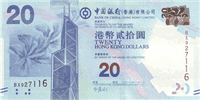 Obverse side of the 20 Hong Kong dollars is showing the Bank of China Tower. |
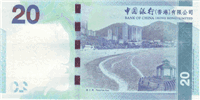 Reverse side of the 20 Hong Kong dollars is showing the Repulse Bay. |
| 50 Hong Kong dollars | |
|---|---|
| Banknote of 50 Hong Kong dollars has dimensions 148×74 mm and main colors are pale aqua, dark gray, dark sea green, cambridge blue, pastel gray, platinum and snow. The banknote of 50 Hong Kong dollars was issued in 2010. | |
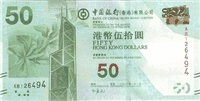 Obverse side of the 50 Hong Kong dollars is showing the Bank of China Tower. |
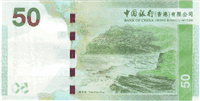 Reverse side of the 50 Hong Kong dollars is showing the Tung Ping Chau. |
| 100 Hong Kong dollars | |
|---|---|
| Banknote of 100 Hong Kong dollars has dimensions 153×72 mm and main colors are pale chestnut, dark terra cotta, tea rose, pale silver, old rose, pastel gray, pearl, timberwolf, almond and almond. The banknote of 100 Hong Kong dollars was issued in 2010. | |
 Obverse side of the 100 Hong Kong dollars is showing the Bank of China Tower. |
 Reverse side of the 100 Hong Kong dollars is showing the Lion Rock. |
| 500 Hong Kong dollars | |
|---|---|
| Banknote of 500 Hong Kong dollars has dimensions 158×80 mm and main colors are rose taupe, bazaar, pale silver, lavender gray, rosy brown, cinereous, ivory and almond. The banknote of 500 Hong Kong dollars was issued in 2010. | |
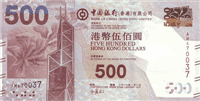 Obverse side of the 500 Hong Kong dollars is showing the Bank of China Tower. |
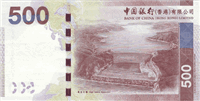 Reverse side of the 500 Hong Kong dollars is showing the High Island Reservoir. |
| 1000 Hong Kong dollars | |
|---|---|
| Banknote of 1000 Hong Kong dollars has dimensions 164×82 mm and main colors are indian red, antique brass, pale copper, tumbleweed, almond, tan, pearl, desert sand, pale spring bud and floral white. The banknote of 1000 Hong Kong dollars was issued in 2010. | |
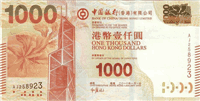 Obverse side of the 1000 Hong Kong dollars is showing the Bank of China Tower. |
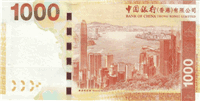 Reverse side of the 1000 Hong Kong dollars is showing the Victoria Harbour. |
Useful links
- About Hong Kong Monetary Authority:
- Hong Kong Monetary Authority
- List of currencies:
- Currencies
- Security and design features of HKD banknotes:
- HKD banknotes
- HKD currency on Wikipedia:
- Hong Kong dollar
- Official Website of Hong Kong Monetary Authority:
- www.hkma.gov.hk
- Commemorative coins:
- Commemorative Coins